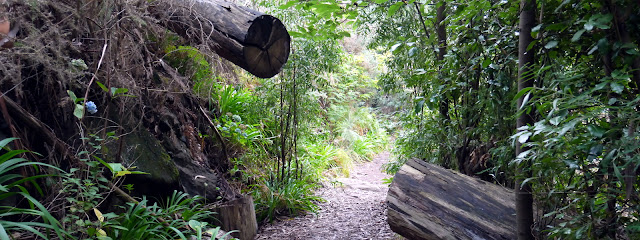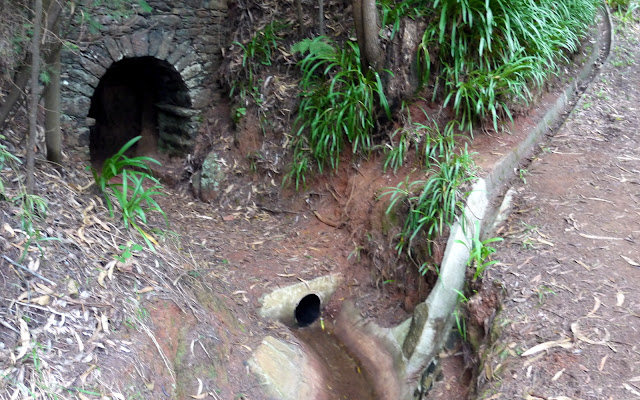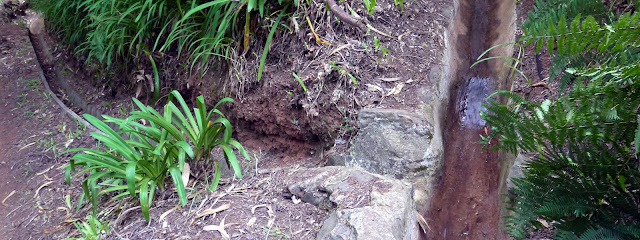Levada da Serra do Faial
The Levada da Serra do Faial once brought water to the Caminho do Meio - the old road on which the Botanical Garden is located - from the Levada do Furado which flows through Ribeiro Frio. The initial section from Funchal was abandoned (though the footpath remains) and the water diverted down a new downhill course to the Levada dos Tornos when the latter was constructed. Beyond Camacha, significant sections are now road or footpath. Being at a relatively high elevation, you can experience either magnificent distant views or an obscure blanket of low cloud - or alternating periods of both!
The walk described here is the section between Funchal (Caminho do Meio) and Camacha (Estrada dos Casais de Além). You can go beyond Camacha to Santo da Serra or even Portela/Ribeiro Frio.
As mentioned, there is no sign of water along the initial stretch of the path, nor of the levada ever having existed, though if you're fortunate with the weather there are, by way of compensation, views of Funchal. There was significant logging going on when I visited, meaning the uphill areas were rather bare. The valley immediately below is used for agriculture.
 As you enter the trees, you come to the point at which the water has been diverted to the later Levada dos Tornos. There's no convenient walking route at this point to link the two, but there is a little further on.
As you enter the trees, you come to the point at which the water has been diverted to the later Levada dos Tornos. There's no convenient walking route at this point to link the two, but there is a little further on. 


 A
signpost at this point confirms your east-west route options, but there
is also a north-south path: the remains of the old, cobbled, Caminho do Pico do Infante crosses the levada at this point. You can follow it downhill with relative ease towards the Levada dos Tornos (a broken tree currently marks
the southward path). There is also an unmarked uphill route north to the Pico do Infante - though you may find yourself surrounded by motorcycle scramblers - where you can cross to the Caminho do Meio and return to the starting point of the levada if you're feeling more adventurous and suitably equipped.
A
signpost at this point confirms your east-west route options, but there
is also a north-south path: the remains of the old, cobbled, Caminho do Pico do Infante crosses the levada at this point. You can follow it downhill with relative ease towards the Levada dos Tornos (a broken tree currently marks
the southward path). There is also an unmarked uphill route north to the Pico do Infante - though you may find yourself surrounded by motorcycle scramblers - where you can cross to the Caminho do Meio and return to the starting point of the levada if you're feeling more adventurous and suitably equipped. If you want to go down to the Levada dos Tornos, follow the path downhill you'll join a paved road: follow it downhill until you come to a main road. As you cross
it, there's a sign to indicate the direction you need to follow. A short
distance down the road you'll see a rather unprepossessing warehouse at
the point the Levada dos Tornos crosses the road.
If you want to go down to the Levada dos Tornos, follow the path downhill you'll join a paved road: follow it downhill until you come to a main road. As you cross
it, there's a sign to indicate the direction you need to follow. A short
distance down the road you'll see a rather unprepossessing warehouse at
the point the Levada dos Tornos crosses the road. Continuing in the direction of Camacha, you have views of the Quinta do Palheiro, from the opposite side.
There are also constant signs of the agriculture supplied by the waters of the levada.
Getting there
If you're arriving by car, one option is to take the ER203 to the point at which the road is crossed by the levada. There is now a small area of car parking giving you the option to park and head either towards Camacha and beyond or towards Funchal. The entry point to the levada in Camacha is on a narrow road used by buses and coaches so not ideal for parking. There is parking in the centre of Camacha but it's a steepish hike up to the levada.If you want to start from the Funchal end, there is (paid) parking at the Estádio da Madeira which appears to be open to the public and from where there is an exit directly onto the Caminho do Meio, though there is still a significant climb up to the start of the levada. See the directions below for getting from the Caminho do Meio to the start of the levada.
From Funchal, you'll have a climb of about 200m over a distance of around 1km from the nearest practical public transport, so if you prefer to walk downhill, make this the endpoint of your journey.
 The Caminho do Meio continues on the other side of Caminho dos Pretos (though it's labelled Caminho do Pico do Infante on OpenStreetMaps), but this is now the original, cobbled surface - and this section of road is absent from Google Maps. It is used by
vehicles, so take care, especially at blind corners. The path leads
uphill, past some rural dwellings and the levada runs off to the
south-east (on the right as you climb the hill) where the sign appears.
The Caminho do Meio continues on the other side of Caminho dos Pretos (though it's labelled Caminho do Pico do Infante on OpenStreetMaps), but this is now the original, cobbled surface - and this section of road is absent from Google Maps. It is used by
vehicles, so take care, especially at blind corners. The path leads
uphill, past some rural dwellings and the levada runs off to the
south-east (on the right as you climb the hill) where the sign appears. 














